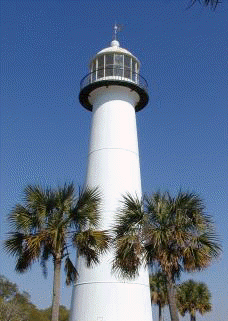 |
TO
~RON'S WORLD12~

~Coquille River Light ~
~Bandon,Oregon~
(1895)
A Brief History
| In southwestern Oregon, not far from Coos Bay, a beautiful river winds its way through the countryside. Although placid in appearance, the waters surrounding the mouth of Coquille River once struck fear into the hearts of mariners. Toward the latter part of the nineteenth century, Oregon's lumber industry was in full swing. The small town of Bandon, near the river entrance, quickly grew into a bustling port. Schooners sailed into the port on a regular basis to ferry loads of harvested lumber.
In 1870, the schooner Commodore foundered on the bar near Coquille's entrance and broke into pieces. Over the next few years, numerous vessels went down in these hazardous waters. Some mariners considered the river bar among the most dangerous on the West Coast. Fifteen years after the Commodore wreck, a stuccoed brick lighthouse was erected near the mouth of Coquille River. Rising 40 feet into the air, the white conical tower was fitted with a fourth-order Fresnel lens. Attached to the tower was a unique, octagonal fog signal building. In 1896, Keeper J. Frank Barker activated the light for the first time. For the next forty-three years, the beacon at Coquille River not only guided vessels through the river entrance, but also served as an important coastal light. Although countless ships were no doubt saved, a number of vessels still went down in the waters near the lighthouse, including several schooners between 1904 and 1905. In 1936, a devastating fire nearly destroyed the town of Bandon. Many residents sought refuge at the lighthouse, which was on the opposite side of the river. After the fire, coastal shipping in the area began to decline significantly. Three years later, the Beacon was deactivated and replace by a small jetty light and a series of buoys. After the government abandoned the station, it fell victim to vandals and the ravages of nature for the next four decades. In 1979, the tower was restored to its former grandeur. In 1991, during the centennial celebration of Bandon, a solar-powered light was ceremoniously lit in the lantern room. Today, the sentinel, is still referred to by locals as "Bandon Light".
~Biloxi Lighthouse~ |


 for her Graphics...
for her Graphics...